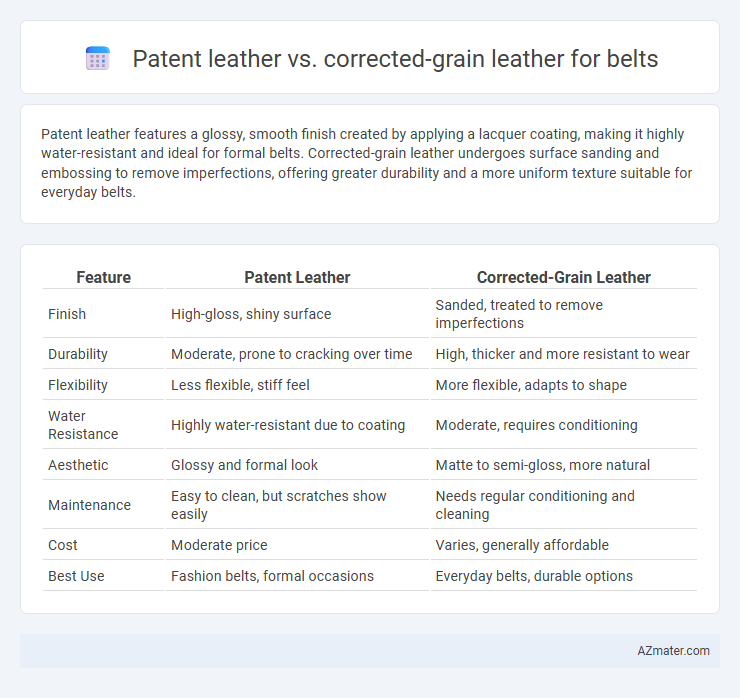Patent leather features a glossy, smooth finish created by applying a lacquer coating, making it highly water-resistant and ideal for formal belts. Corrected-grain leather undergoes surface sanding and embossing to remove imperfections, offering greater durability and a more uniform texture suitable for everyday belts.
Table of Comparison
| Feature | Patent Leather | Corrected-Grain Leather |
|---|---|---|
| Finish | High-gloss, shiny surface | Sanded, treated to remove imperfections |
| Durability | Moderate, prone to cracking over time | High, thicker and more resistant to wear |
| Flexibility | Less flexible, stiff feel | More flexible, adapts to shape |
| Water Resistance | Highly water-resistant due to coating | Moderate, requires conditioning |
| Aesthetic | Glossy and formal look | Matte to semi-gloss, more natural |
| Maintenance | Easy to clean, but scratches show easily | Needs regular conditioning and cleaning |
| Cost | Moderate price | Varies, generally affordable |
| Best Use | Fashion belts, formal occasions | Everyday belts, durable options |
Overview: Patent Leather vs Corrected-Grain Leather
Patent leather features a glossy, smooth finish achieved through a lacquer coating, providing high shine and water resistance ideal for formal belts. Corrected-grain leather is made by sanding and embossing the hide to remove imperfections, resulting in a more durable and uniform surface suitable for everyday use. Both types offer distinct aesthetics and functionality, with patent leather emphasizing style and corrected-grain prioritizing durability and consistency.
Material Composition and Manufacturing Processes
Patent leather features a high-gloss, smooth finish achieved by coating the natural grain leather with a layer of lacquer or plastic, enhancing its water resistance and shine. Corrected-grain leather is made by sanding away the natural surface imperfections and then embossing an artificial grain pattern before applying pigments and finishes for uniformity. Patent leather manufacturing involves multiple polishing and coating steps for a mirror-like surface, whereas corrected-grain leather undergoes mechanical abrasion and embossing to create a consistent texture suitable for durable belts.
Visual Appeal and Shine: Aesthetic Differences
Patent leather offers a high-gloss, mirror-like finish that enhances the belt's visual appeal with a sleek and polished look, making it ideal for formal occasions. Corrected-grain leather features a more natural texture with a subtle shine achieved through surface buffing and coating, providing a matte to semi-gloss finish that emphasizes durability and a classic appearance. The distinct aesthetic differences lie in patent leather's uniform, reflective surface versus corrected-grain leather's textured, less shiny, and understated elegance.
Durability and Wear-Resistance Comparison
Patent leather features a high-gloss finish created by applying a lacquer coating, which enhances its wear-resistance but can crack or lose shine with frequent bending or exposure to harsh conditions. Corrected-grain leather, treated with a textured surface and protective coatings, offers superior durability and resists scratches, making it more suitable for belts subjected to daily wear and heavy use. The corrected-grain leather's natural fibrous structure combined with surface treatment provides better longevity and toughness compared to the more delicate, finish-dependent patent leather.
Comfort and Flexibility for Everyday Use
Patent leather belts offer a sleek, glossy finish but tend to be stiffer and less breathable, which can limit comfort and flexibility during extended wear. Corrected-grain leather belts, treated to remove imperfections and sanded for uniformity, provide greater softness and flexibility, making them more suitable for everyday use. The enhanced pliability and moisture-wicking properties of corrected-grain leather contribute to a comfortable fit that adapts well to daily movements.
Maintenance and Cleaning Requirements
Patent leather belts require minimal maintenance due to their glossy, lacquered finish that resists water and stains, making cleaning as simple as wiping with a damp cloth. Corrected-grain leather belts, treated to remove natural imperfections and often coated with a finish, need regular conditioning to prevent drying and cracking, and cleaning with a leather-specific cleaner to maintain suppleness. Proper upkeep of each type preserves appearance and extends belt longevity, with patent leather favoring ease and corrected-grain leather demanding more attentive care.
Cost Analysis: Price vs. Value
Patent leather belts typically command higher prices due to their glossy finish and labor-intensive manufacturing process, offering a sleek look suitable for formal attire. Corrected-grain leather belts are more affordable, featuring surface treatments that mask imperfections but may compromise durability and aging quality. When comparing cost to value, patent leather belts justify their premium through aesthetics and longevity, while corrected-grain options provide budget-friendly versatility at the expense of long-term wear.
Suitability for Formal and Casual Belts
Patent leather offers a glossy, mirror-like finish that enhances formal belt designs, making it ideal for events requiring polished and sophisticated style. Corrected-grain leather features a textured, durable surface with a slight matte finish, providing versatility for both casual and semi-formal belts. For formal occasions, patent leather exemplifies elegance, while corrected-grain leather balances durability and style suited for everyday casual wear.
Environmental Impact and Sustainability Factors
Patent leather production involves a heavy use of synthetic coatings and chemicals, contributing to higher environmental pollution and lower biodegradability compared to corrected-grain leather. Corrected-grain leather is typically produced using more natural tanning processes and can utilize hides that would otherwise be discarded, promoting waste reduction and resource efficiency. Both types pose sustainability challenges, but corrected-grain leather offers a relatively lower environmental footprint due to its more traditional processing and potential for longer durability.
How to Choose the Right Leather for Your Belt
Choosing between patent leather and corrected-grain leather for a belt depends on the desired style and durability. Patent leather offers a high-gloss, shiny finish ideal for formal occasions, while corrected-grain leather provides a more durable, versatile, and matte appearance suitable for everyday wear. Consider the belt's use, maintenance needs, and the leather's finish to select the right material that complements your wardrobe and lasts through regular use.

Infographic: Patent leather vs Corrected-grain leather for Belt
 azmater.com
azmater.com